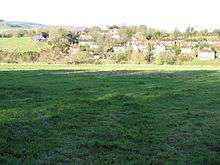Burpham
| Burpham | |
 Burpham |
|
| Area | 12.38 km2 (4.78 sq mi) [1] |
|---|---|
| Population | 145 (Civil Parish.2011)[2] |
| – density | 12/km2 (31/sq mi) |
| OS grid reference | TQ039089 |
| – London | 47 miles (76 km) NNE |
| Civil parish | Burpham |
| District | Arun |
| Shire county | West Sussex |
| Region | South East |
| Country | England |
| Sovereign state | United Kingdom |
| Post town | Arundel |
| Postcode district | BN18 |
| Dialling code | 01903 |
| Police | Sussex |
| Fire | West Sussex |
| Ambulance | South East Coast |
| EU Parliament | South East England |
| UK Parliament | Arundel and South Downs |
|
|
Coordinates: 50°52′12″N 0°31′30″W / 50.870°N 0.525°W

Burpham is a rural village and civil parish in the Arun District of West Sussex, England. The village is on an arm of the River Arun slightly less than 2 miles (3.2 km) northeast of Arundel.
Just over half of the population is of non working age (retired or younger children).
Wepham is a rural hamlet in the parish about 1.7 miles (2.7 km) northeast of Arundel on the road between Burpham and Warningcamp.
History
The surrounding area has yielded Iron Age and Neolithic remains including the bones of an elephant near Peppering Farm.
The village is next to the site of a Saxon Burh (an Old English term for "fortification") with earthworks to protect against Viking attack up the River Arun. It is one of a series of burhs ordered by Alfred the Great or his successor, Edward the Elder in about AD 900 and listed in the Burghal Hidage. Burpham's toponym is derived from burh.
The Church of England parish church of Saint Mary is of Saxon origin. It has a lepers' window by which lepers could watch the Mass. English Heritage lists the building as a Grade I listed building.[3]
Burpham has one main street, mainly of thatched Sussex flint cottages.
Burpham has a rich literary history. Mervyn Peake and his family lived here and he walked the South Downs while devising the fantasy characters of Gormenghast. John Cowper Powys moved to Burpham with his wife Margaret in 1902 and wrote warmly of Burpham in his Autobiography (1934).[4] His son Littleton Alfred Powys was born in the village later that year and subsequently grew up living with his mother whilst John Cowper Powys toured America delivering public lectures and writing.[5] The Rev. Tickner Edwardes, who lived in what is now the Burpham Country House Hotel, when Vicar of Burpham, was a noted naturalist, and wrote many books including The Lore of the Honey-Bee, as well as authoring romantic novels and early films of the 1920s such as Tansy, the story of a love triangle between a village girl and two brothers.[6] A blue plaque on the building commemorates him. Both Peake and Edwardes are buried in St. Mary's churchyard.
Amenities
Burpham has notable views across the Arun and its water meadows towards Arundel Castle, Arundel Cathedral and Arundel Priory. The village has a century-old cricket pitch where W. G. Grace played. There is one public house, The George at Burpham, that was built in 1736 and now holds an AA Rosette as a gastropub.[7]
References
- Notes
- ↑ "2001 Census: West Sussex – Population by Parish" (PDF). West Sussex County Council. Archived from the original (PDF) on 8 June 2011. Retrieved 26 March 2009.
- ↑ Key Statistics; Quick Statistics: Population Density United Kingdom Census 2011 Office for National Statistics Retrieved 21 November 2013
- ↑ "Name: THE PARISH CHURCH OF ST MARY List entry Number: 1027657". Historic England. Retrieved 12 June 2016.
- ↑ London: Macdonald, 1967, pp.316-84.
- ↑ "Descents of Memory - The Life of John Cowper Powys" - M Krissdottir pub Duckworth 2007
- ↑ Tansy (1921) Petley, Julian. BFI Screen Online. Retrieved 02-10-2010.
- ↑ The George at Burpham, Burpham, Arundel
- Further reading
- Nairn, Ian; Pevsner, Nikolaus (1965). Sussex. The Buildings of England. Harmondsworth: Penguin Books. pp. 120–122. ISBN 0-14-071028-0.
External links
| Wikimedia Commons has media related to Burpham. |